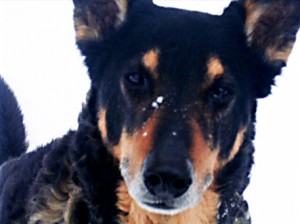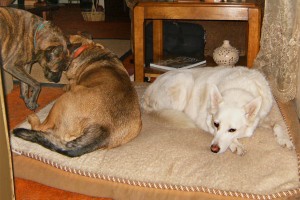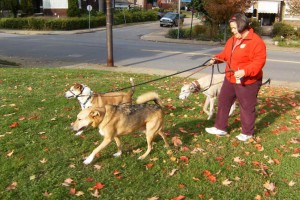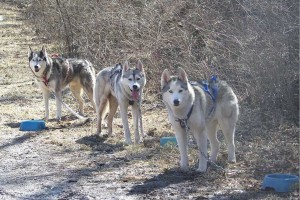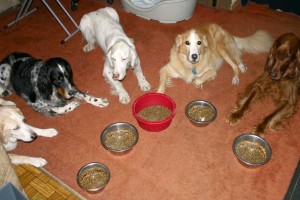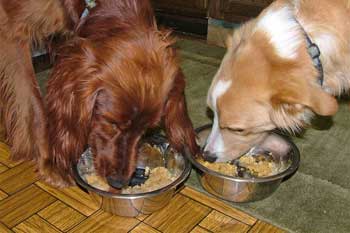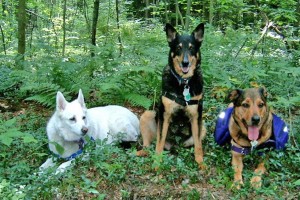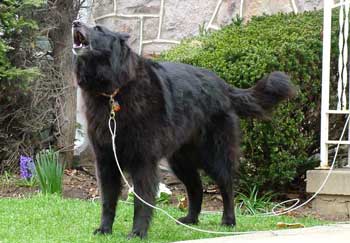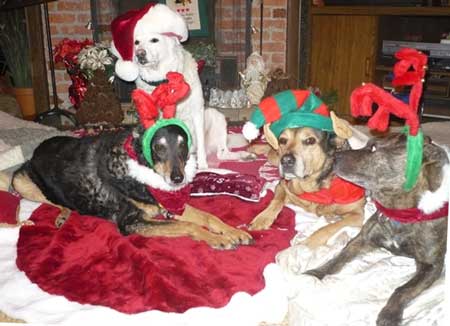And Then There Were Three: Love, Loss and the Multiple Dog Home
I did not yet expect to find myself in this position, though some would say that I should not be surprised. Merlin was, after all, about to turn thirteen years old and he had been battling the worst of cancers, hemangiosarmcoma for over seven months. He had been beating the odds so I got a little more secure than I should have gotten, I suppose. I should probably explain before I go much further, that my heart dog, my sweet baby boy Merlin, crossed the Rainbow Bridge on September 24, 2011.
Normally, I would not be writing another blog so quickly after just completing one. But this one is more personal than most. I need to tell it if only to get it out of my system but maybe my experience can help other multiple dog households that find themselves in similar circumstances, though I would not wish this on anyone.
It all started in February of this year when we had to rush to the vet only to be told that an unknown mass was showing up on an x-rays. Several doctors later, after said unknown mass’ removal, it was diagnosed as the dreaded afore mentioned disease.
I must be completely honest as I expect that the same thought has crossed the minds of other multiple dog parents. My first thought was why THIS dog. Please don’t misunderstand me. I love all of my dogs more than words can convey. But this dog is/was different. He feels like part of my DNA. My heart. My soul. Maybe it was because he was my first boy dog. Maybe it was how we chose each other. Maybe it was any number of things but WHY THIS DOG??? That question may never be answered but because it was THIS DOG, maybe the lessons learned on this roller coaster ride will be more firmly imprinted in my soul.
Thus began my journey to try and save my dog’s life, at least from this horrible disease. This process necessitated that much more time be spent tending to Merlin than my other three dogs, what with multiple consultations with specialists and seemingly endless chemo visits and follow up check-ups. And let’s not forget the additional pills he was getting and endless research into what might help him live longer.
Merlin reveled in the attention, being the Velcro boy to me that he was. But quite frankly, he was always the one to ask for more attention so this was his show now. This could have easily caused quite a few problems with my other dogs. They could have easily been very jealous and started acting out as a result of that jealousy. But they didn’t. I am very lucky that was not the case. But most of this was not blind luck. It was actually the result of setting up my fur family to roll with the situation that they are presented with.
How did I do this? I forged a very strong relationship with all of my crew from day one, based on mutual respect and love. I made it clear that everyone mattered in this household and that all creatures here should be respectful of each other in any way that they can. There is little pushing and shoving here. Everyone takes turns. Everyone gets loved. Everyone gets snuggled. Younger pups are taught to be body aware of older pups. Older pups are taught to be patient with younger pups antics. No one takes anything from anyone else without permission. We watch out for each other. If one hurts, we all hurt. We are one.
Everyone else seemed to realize that there was a need to be okay with Merlin’s multiple car trips alone with me. Maybe he smelled different. Of course, he smelled different. Dogs are able to detect cancer with their noses after all. They had to know. Too bad they can’t talk. Wouldn’t it be nice to be able to ask them what they thought of all this? Maybe not. Maybe that would involve a more openly raw emotional discussion than any of us can deal with right now. We communicate without words. That is enough. It’s all I need. It’s all WE need.
In any case, I tried very hard to make up for extra time with Merlin. I made an effort to give each other dog extra attention at home. I spent time having special group time for us at home. There were extra group trips together and longer group walks. There were extra chewies and as many play times that I could get them to agree to. I think they were okay with it.
I would be lying if I said that I handled all of this perfectly. Merlin was my heart dog. It’s hard to hide that kind of panic for my baby’s survival. I am sure that I spent more time snuggling with him than the others more than once. I know I did. I am sure that I showed anxiety at too much body bumping by the others more than once. I am sure that all that fussing over whether he was eating or not, did not always go unnoticed. I am sure that I showed more stress than I would have preferred far more than I would have liked. But thankfully, they rolled with it.
There were small signs that at least Siri was a bit stressed about the somewhat unequal attention. She was a bit pushier than usual about treats but that is also very Siri-like at many normal times. She does lean towards pushy. Other stress signs included the growing group reluctance to eat their breakfast, whenever Merlin was feeling poorly. I assumed it was because Merlin was eating special meals so I always made sure that they got some of what he was eating. That sometimes worked but not always.
Now that Merlin has left us for the Rainbow Bridge, I know that the stress signs were actually worry for him. Now they are eating the same thing they were eating before, with gusto. They were worried about him. They no longer have that worry. Siri would go and smell him or nudge him gently when he would not eat. Now she knows he is free so she eats. It is important to realize that ordeals like this also cause stress on your other dogs. They are not blind. They knew something was wrong.
The others were okay with us walking slower than usual when Merlin was tired after chemo. They were okay with shorter walks. They were okay with what were not actually even walks at times. I was also not up to much on some days so on those days, we would go to one of our favorite places and the dogs were free to walk about off leash as much as they wanted. This allowed Merlin (and Kera, whose back legs are not what they used to be) to simply lay in the grass and chill while the others walked. After Merlin’s first scary brush with mortality, about a month and a half prior to when he left us, we had such a trip. Merlin did not want to get out of the car at all for the first fifteen minutes we were there. He was gaining his strength back. He just lay in the car with all the doors open and watched and grinned. Siri stood sentry by his door and would not move until he opted to come out. Then she happily escorted him to where he chose to lay. She also followed closely behind when he decide a bit of walking about would do him good.
They were all present when he went over the bridge. He had another bleed (an HSA term that I hope you never need to know more about) and he did not recover so I chose to end his suffering. We have a wonderful in-home vet here who specializes in hospice patients. I called my friend who had recently used her and learned that the vet would be dropping off ashes at her home that morning. My friend lives a short half a mile from me so my decision seemed to be confirmed by this coincidence. With my friend there to assist with my other dogs, Merlin’s passing was as peaceful as it could get for such a situation. Certainly more peaceful than the extreme discomfort he was feeling before hand.
The other dogs were permitted to say their goodbyes as well. Siri sniffed him, Trent was very nervous and refused to look at him. Kera, well Kera stepped on him. She’s going a bit senile sadly. After the vet left and took Merlin with her to be cremated, I spotted Siri sniffing the bed where he passed. They spent the rest of the day with me mourning in bed. No one protested the lack of a walk that day. They stayed close by my side and we comforted one another.
A short three days later would have been Merlin’s thirteenth birthday. I bought them vanilla ice cream to celebrate as that was Merlin’s favorite vice. And they enjoyed beef tendons after dessert. Or rather two of them did. Trent was reluctant to chew. On a hunch, I sat with him and hugged him and told him that our little boy would want him to enjoy him chewy in his honor. I don’t know what words he actually understood but after our snuggle and chat, he chewed his chewy.
There are other signs that they realize we are missing a crucial family member. No one wanted to lie on his bed for several days. No one will take his usual spot in the car. But on the opposite end of the spectrum, two days after Merlin left us, I spotted Siri coming out of the bathroom while I was working on the computer. Merlin loved to lay in there and watch me work. Siri never goes in there. She was seeking his presence, I believe. I hugged her.
We are all trying to remember just the happy times now, I think. I would be lying if I said that I missed the extra work, the amazing stress of always having this potential sadness hanging over our heads and the effort of trying to be positive every moment. But I would gladly do every single second of it all over again if it meant I could have my baby boy with me again. I have too much time on my hands at home now. I keep busy. It is evident that Merlin was the one of my crew with initiative. My other pups mostly wait for me to cue them. Merlin was a question asker. I am encouraging them to ask their own questions now.
I don’t really know what all I can advise as every situation will be different. But maybe some of what I have done with my crew can help shed some light on another multiple dog household that finds themselves in this position. Be positive, take care of yourself and ask for help when you need it. You have to be taken care of to take care of others. Never forget that. Find a support system and use it. The internet is a great place for that. Use it. I did and I am grateful for the support that I got. Godspeed to all those special pups who are leaving us for the moment. And hugs to the pup parents.
To my sweet baby boy, until we meet again, I love you every second of every day.
Posted in: Projects
Leave a Comment (14) →
